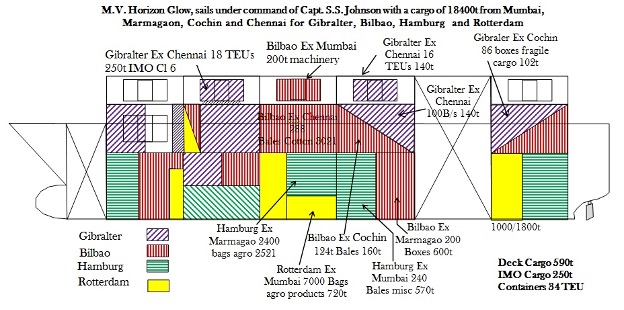For a ship to be commercially viable for carrying cargo the spaces on board need to be optimally utilized. This means cargo cannot be dumped haphazardly into the cargo spaces but rather must be loaded in an organized manner. This is done through careful planning and the result of such careful planning is a cargo plan.
A cargo plan is a detailed blueprint that shows the distribution of all cargo parcels stowed on board a ship for a voyage. Each entry on the plan specifies the quantity, weight, and discharge port for each parcel of cargo.
For tankers, it is a plan presenting the quantities and descriptions of the various grades of oil carried in the ship’s cargo tanks after loading.
Stowing cargo on a ship for optimal space utilization is a complicated process that requires careful planning. This write-up explains what a ship cargo plan is, how it is prepared, and its importance.

What is the Purpose of the Cargo Plan?
A cargo plan enables full utilization of a vessel’s weight and volume carrying capacities, the prevention of damage to cargo during transit, and the expedient and quick loading and unloading of cargo. Its most common purpose however is to prevent short delivery at the port of discharge and reduce the likelihood of over carriage at the discharge port.
This document is essential for the safe operation of the ship and ensures that the cargo is stowed correctly. The plan provides an overview of the distribution of the cargo and identifies potential access points to it in the event of a fire or other situations that might require quick and easy access to the cargo. It is also a requirement of most insurance policies.

How is a Cargo Plan Prepared?
Preparing a ship cargo plan is a complex task that requires knowledge of the ship, the cargo, and the cargo gear available at the loading and discharge ports. Factors that need to be considered include:
- The Stability of the ship.
- Structural Safety
- Safety Codes
- Economy
- Intermixing
Ships must be able to withstand a variety of internal and external factors that could jeopardize their seaworthiness and the safety of their crew and cargo.
Vessels can withstand a variety of, and occasionally very intense, environmental conditions as well as external forces like waves, seawater, wind, internal mass weight, and free surface effect.
The plan must also take into consideration factors such as structural safety, that is to load in such a manner so as to remain within the prescribed working loads for the ship structure parts such as the decks and so forth.
The plan must also ensure the various cargo safety codes like that for Dangerous goods etc are complied with. Cargo compatibility issues must also be taken into account.
Since the ship’s main goal is to make the owners and operators as much money as possible, this can be done by carrying or transporting as much cargo as possible in a single trip.
So, a good cargo plan makes sure that the available cargo space is used as efficiently as possible. Of course, this is subject to the safety rules we’ve already talked about, and you can’t overload a ship to make more money if it puts the ship, its crew, and the cargo it’s carrying in danger.
Proper planning of cargo stow becomes necessary for avoiding intermixing of cargo. In the event that more than one kind of cargo needs to be transported on a single trip, it is essential that only cargo that is compatible with one another be stowed together in the same cargo space. Intermixing cargo poses the risk of damaging it or even causing some unwanted chemical reactions.
What is the Importance of a Cargo Plan?
A ship cargo plan is a critical document that outlines the type and quantity of cargo that a ship is carrying. This plan is essential for a number of reasons, including safety, regulatory compliance, and efficient loading and unloading of the ship.
The cargo plan is prepared before the ship leaves port and is updated throughout the voyage as cargo is added or removed. The plan is used by the ship’s captain and crew to ensure that the cargo is loaded and secured properly, and to keep track of where all the cargo is located on the ship.
In the event of an emergency, the cargo plan can be used to quickly and easily identify which areas of the ship contain dangerous or poisonous cargo, and which areas are safe. This information is crucial for the safety of the ship’s crew and passengers.
Before loading, a pre-stowage plan is prepared to guide the loading. The final cargo plan, which includes all necessary stability calculations, is prepared by the Chief Officer before the ship departs. Copies of the final plan are created and sent to the port agents before the ship sails from the port. This is to enable necessary cargo handling arrangements to be made at the various ports of call on the voyage.
What Goes Into a Ship Cargo Plan?
When planning cargo stowage, careful consideration must be given to the order in which they will be discharged. It is important to carefully plan both the sequence of loading and the location of the cargo so that at each stage there is easy and ready access. Information regarding the cargo, such as the gross weight of the cargo or the cargo units as well as any special remarks detailed in the shipping documents, should be recorded and utilized in the planning process.
As much as possible, cargo should be stowed to allow passage to key areas. Deck cargo must be stowed according to statutes, cargo rules, special contracts, etc. For safe access, keep cargo away from hatch coamings.
Ensure access to safety equipment, firefighting equipment (especially hydrants), and sounding pipes. Lashings and securing points should be painted white to increase visibility.
It is also important to remember that heavier loads should not be stacked on top of lighter ones. This could cause the stow to collapse, which would create a stability issue.
It is important to remember that fragile cargo should never be overstacked with heavy cargo. It will result in the cargo underneath being damaged – crushing damage- as a result. As much as possible, cargo should be stowed to allow passage to key areas.
Securing cargo should be paramount and should be done as per the vessel’s cargo securing manual. This is of particular importance during the transport of heavy cargoes or cargoes with abnormal physical dimensions. This is to ensure that there is no possibility of structural damage to the ship occurring and to maintain adequate stability throughout the voyage.
Conclusion.
The Ship Cargo plan is an essential component of international trade because it enables ships to maximize profits through the strategic placement of goods into cargo spaces.
As a critical tool for any vessel carrying goods or materials, it enables full utilization of a vessel’s weight and volume carrying capacities, the prevention of damage to cargo during transportation, and the expedient and quick loading and unloading of cargo.
By providing a clear and concise plan for the ship’s cargo, a cargo plan ensures delays, disruptions, and mistakes, which could cost the ship owner money are avoided.
- Sustainable and Luxurious: Discovering Split’s Yachting Paradise – April 26, 2024
- MarineTraffic vs VesselFinder: Which Is Better Vessel Tracking Service? – February 14, 2024
- Port Costs: A Comprehensive Guide to Port Dues and Fees for Cargo Ships – February 12, 2024






Leave a Reply